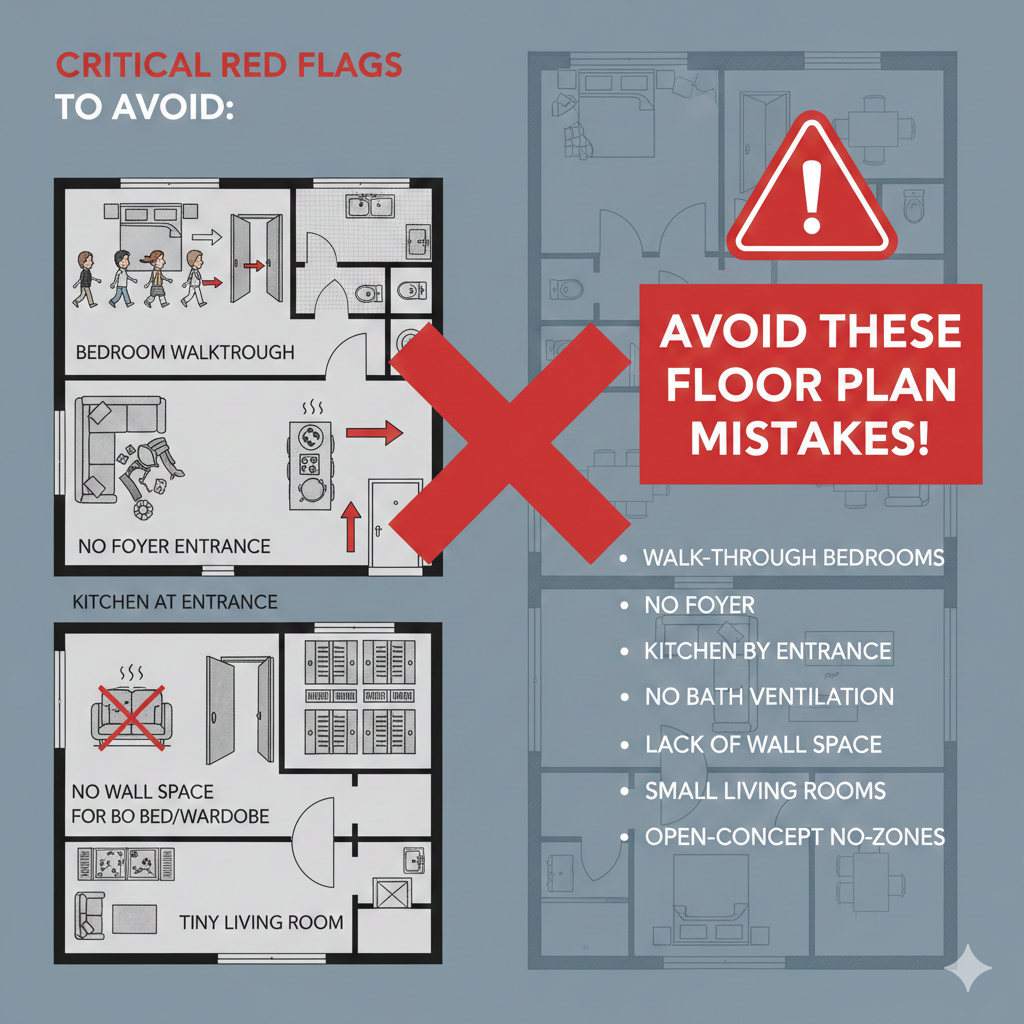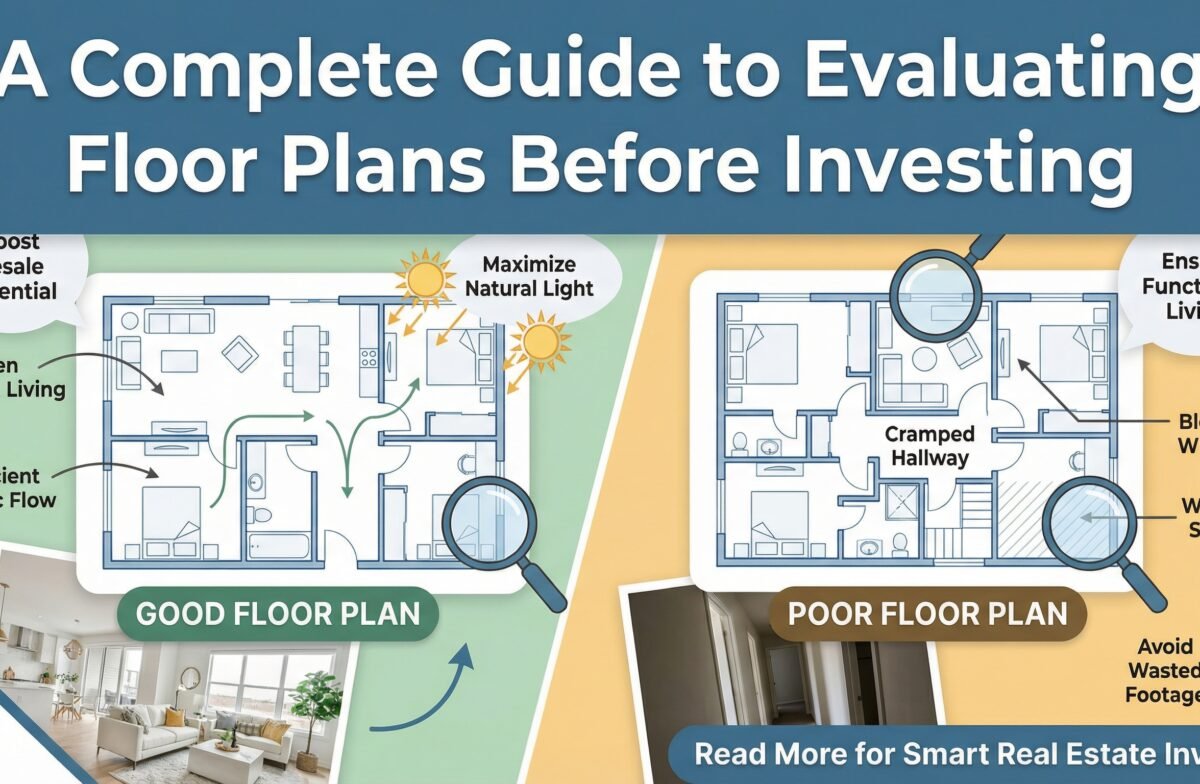When investing in real estate, most buyers focus on location, price, and amenities while often overlooking one of the most critical factors—the floor plan. A well-designed floor plan determines how you’ll live, work, and move within your home for years to come. Poor floor plan choices can lead to wasted space, inadequate natural light, inefficient traffic flow, and ultimately decreased property value and rental appeal. Research shows that 51% of buyers are positively influenced by floor plans when making purchase decisions, and properties with professional floor plans receive significantly more engagement than those without. Understanding how to critically evaluate floor plans before investing protects your money and ensures you choose a home that truly works for your lifestyle and offers strong resale potential.
Essential Elements to Examine in Any Floor Plan:
- Room Layout and Functional Flow: The foundation of good floor plan evaluation is assessing how spaces connect and flow. Look for layouts offering seamless transitions between rooms with efficient traffic patterns that align with daily routines. Avoid floor plans with long, narrow hallways that waste valuable square footage or create isolated rooms that disrupt natural movement. Check whether the kitchen connects logically to the dining area, whether bedrooms are clustered together for privacy, and whether bathrooms are conveniently located relative to bedrooms and common areas. The flow should feel intuitive—you shouldn’t need to walk through one bedroom to reach another or pass through the kitchen to access the living room.
- Natural Light and Ventilation: One of the most overlooked yet critical aspects of floor plan evaluation is assessing natural light and cross-ventilation potential. In India, building regulations require window area to be at least 10% of room floor area for ventilation and 15% for natural light, but smart buyers look beyond minimum compliance. Examine window placement carefully—east and north-facing windows provide soft, steady daylight without harsh glare or excessive heat. Cross-ventilation requires windows or openings on opposite walls to create natural airflow, which is essential for healthy living and energy savings. Check whether living spaces receive ample daylight throughout the day and whether bedrooms get pleasant morning light. Apartments with proper cross-ventilation reduce dependency on air conditioning, lower energy bills, and create healthier indoor environments by preventing moisture buildup and mold growth.
- Room Dimensions and Proportions: Floor plans show room measurements, but you must analyze whether these dimensions translate to livable, comfortable spaces. A bedroom might technically qualify as “10×12 feet” but feel cramped if door placement, built-in wardrobes, or window locations limit furniture arrangement options. Evaluate whether each room can accommodate standard furniture comfortably—can a master bedroom fit a king-size bed with adequate walking space? Will your dining table fit in the designated dining area without blocking pathways? Check ceiling heights as well, as low ceilings can make even large rooms feel claustrophobic. Avoid rooms with awkward proportions like extremely narrow or irregular shapes that create unusable corners and limit furniture placement flexibility.
- Storage and Utility Spaces: Adequate storage separates functional homes from cluttered ones. Examine the floor plan for built-in wardrobes, linen closets, utility rooms, and kitchen storage solutions. Modern homes should include dedicated spaces for everyday items—a store room for suitcases and seasonal items, adequate kitchen cabinets and pantry space, and bathroom storage for toiletries and cleaning supplies. Check whether there’s space for washing machines, water heaters, and other utilities without compromising living areas. Insufficient storage forces residents to purchase additional furniture or rent external storage, both adding unnecessary costs and cluttering the home.
- Privacy and Sound Control: Evaluate how the floor plan addresses privacy needs and noise management. Bedrooms should be positioned away from noisy common areas like living rooms and kitchens. Check whether bathrooms share walls with bedrooms—specifically whether toilet walls adjoin bedroom headboard walls, which creates uncomfortable noise issues. In apartments, assess whether your living room shares a wall with a neighbor’s bedroom, potentially causing disturbance issues. Master bedrooms should offer maximum privacy with ensuite bathrooms and preferably separate from children’s rooms or guest bedrooms. Open floor plans, while trendy, can create noise issues if not properly designed with some acoustic separation between active zones and quiet zones.
- Kitchen Design and Workflow: The kitchen deserves special attention as it’s among the most-used spaces. Evaluate the kitchen’s work triangle—the relationship between the sink, stove, and refrigerator. Efficient kitchens position these three elements in a triangular layout minimizing walking distance while cooking. Check for adequate counter space for meal preparation, sufficient cabinet storage, and proper ventilation through windows or chimney placement. Modern buyers prefer kitchens with some connection to dining or living areas, but complete open kitchens can spread cooking odors throughout the home. Consider whether there’s space for appliances like microwaves, dishwashers, and adequate electrical points for kitchen gadgets.
- Bathroom Placement and Features: Bathrooms significantly impact daily comfort and property value. Assess whether bathrooms are conveniently located—master bedrooms should have attached bathrooms, while common bathrooms should be easily accessible from living areas without walking through private spaces. Check bathroom sizes to ensure they accommodate fixtures comfortably with adequate moving space. Indian homes should have proper wet and dry separation, preventing water from spreading throughout the bathroom. Evaluate ventilation—bathrooms need windows or exhaust systems to prevent moisture accumulation and mold. Poor bathroom placement or inadequate ventilation creates long-term maintenance issues and reduces property appeal.
- Balcony and Outdoor Space Integration: Balconies and outdoor spaces extend living areas and improve quality of life, but their value depends on thoughtful integration. Examine balcony sizes—tiny token balconies barely accommodating a single chair offer limited utility. Check balcony orientation for sunlight exposure and views. East or north-facing balconies provide pleasant morning or afternoon spaces without harsh sun, while west-facing balconies can become uncomfortably hot. Assess whether balconies connect logically to living areas or bedrooms and whether they offer adequate privacy from neighbors. Well-designed floor plans integrate outdoor spaces seamlessly with interior rooms, creating expanded living zones rather than awkward appendages.
- Future Flexibility and Adaptability: Smart investors consider not just current needs but future requirements. Does the floor plan allow for easy modifications as your family grows or lifestyle changes? Can a study room convert into a nursery? Could a spare bedroom function as a home office or elderly parent’s room? Bonus rooms or flex spaces add significant value by adapting to changing needs. Consider whether walls are load-bearing or can be modified later, whether there’s space to add built-in storage, and whether room functions can evolve without major structural changes. Floor plans offering flexibility maintain relevance and value longer than rigid layouts serving only specific purposes.
- Wasted vs. Usable Space Analysis: Not all square footage is equally valuable. Calculate actual usable space versus wasted areas like oversized corridors, awkward corners, or dead-end nooks. Some floor plans inflate total area with circulation spaces that add little functional value. Compare the carpet area (actual usable floor space) with the total area shown. Efficient floor plans maximize usable space with minimal wasted circulation areas. Watch for floor plans with long corridors connecting rooms—while they may create grand entrances, they consume valuable square footage better utilized in living areas. Irregular shapes with many corners and angles often create unusable pockets that don’t accommodate furniture or serve any purpose.
Critical Red Flags to Avoid:

Certain floor plan features should raise immediate concerns. Avoid apartments where you must pass through one bedroom to reach another—this destroys privacy and creates constant disruption. Be wary of floor plans where the main entrance opens directly into living rooms without a proper foyer or transition space. Kitchens positioned adjacent to or visible from main entrances create poor impressions for visitors and allow cooking odors to greet guests immediately.
Watch for bathrooms lacking proper ventilation or windows—these spaces will always feel damp and unpleasant. Bedrooms without adequate wall space for bed placement or wardrobes due to excessive door and window openings present furniture arrangement challenges. Living rooms too small to accommodate standard sofa sets comfortably indicate poor space planning. Avoid floor plans where all rooms open into a single central space without defined zones—this creates noise issues and lack of privacy.
How to Effectively Review Floor Plans:
Start by obtaining professional 2D floor plans showing accurate measurements, scale, and a compass indicating north orientation. Walk through the floor plan mentally, imagining your daily routine—morning preparation, meal times, work-from-home scenarios, evening relaxation, and guest visits. Mark your furniture placement on the plan to verify everything fits comfortably with adequate circulation space.
Visit the actual property at different times—morning, afternoon, and evening—to observe natural light patterns and ambient noise levels at various hours. Compare the physical space with the floor plan to verify accuracy, as some developers use misleading representations making rooms appear larger. If possible, speak with existing residents about their living experience, particularly regarding light, ventilation, noise, and any floor plan limitations they’ve discovered.
Consider consulting an architect or interior designer for professional floor plan evaluation, especially for expensive purchases. Their trained eye can spot issues that laypeople might miss and suggest potential modifications or workarounds. Professional evaluation fees are minimal compared to purchasing a poorly designed property you’ll regret for years.
Floor plans are the DNA of your future home—they determine every aspect of your daily living experience and significantly impact property value and resale potential. Properties with well-designed, functional floor plans command premium prices, rent faster at higher rates, and appreciate better than equivalently located properties with poor layouts. Before committing to any property investment, dedicate serious time to thorough floor plan evaluation. Look beyond aesthetics and marketing materials to assess actual functionality, livability, and long-term suitability. Remember, you can renovate interiors and upgrade finishes, but you cannot fundamentally change a floor plan’s basic layout without massive expense and structural complications. Choosing the right floor plan from the beginning ensures your property investment delivers both lifestyle satisfaction and strong financial returns. Take your time, evaluate critically, and never compromise on fundamental floor plan quality regardless of other attractive features—the layout you choose today will shape your life for years to come.




